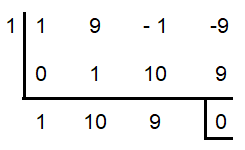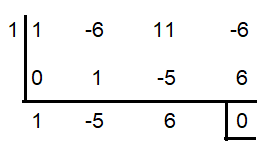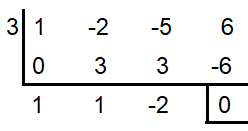SOLVING CUBIC POLYNOMIAL EQUATIONS
Subscribe to our ▶️ YouTube channel 🔴 for the latest videos, updates, and tips.
The polynomial which is in the form
ax3 + bx2 + cx + d
is known as cubic polynomial.
By solving cubic polynomial will have three values of x. Those are x-intercepts. To find those values, we should factories it.
Get the factors using grouping method, get linear factors. Then equating each factors to zero, we will get three values as solutions.
3) Remainder theorem.
Problem 1 :
Solving x3 + 9x2 - x - 9 = 0 we get the following roots
(a) ± 1,-9 (b) ±1, ±9 (c) ±1, 9 (d) None
Solution :

So, factors are (x - 1)(x2 + 10x + 9).
x2 + 10x + 9 = (x + 1) (x + 9)
Equating each factor to zero, we get
x + 1 = 0 x - 1 = 0 x + 9 = 0
x = -1, 1 and 9.
Problem 2 :
The solution of the cubic equation x3 - 6x2 + 11 x - 6 = 0 is given by the triplet
(a) (-1, 1, -2) (b) (1, 2, 3) (c) (-2, 2, 3) (d) (0, 4, -5)
Solution :

So, the factors are (x - 1) (x2 - 5x + 6)
x2 - 5x + 6 = (x - 2) (x - 3)
Equating each factor to zero, we get
x - 1 = 0 x - 2 = 0 x - 3 = 0
x = 1, 2 and 3
Problem 3 :
For the given polynomial
x3 - 2x2 - 5x + 6
If 3 is one of the zeroes, find the others.

writing the left over as quadratic polynomial, we get
x2 + x - 2
To get the other factors,
x2 + x - 2 = 0
(x + 2) (x - 1) = 0
x = -2 and x = 1
So, the three zeroes are -2, 1 and 3.
Problem 4 :
Is x = 4 a root of the equation x3 − 6x2 + 9x + 1 = 0?
Solution :
Let p(x) = x3 − 6x2 + 9x + 1
To check if x = 4 is a factor, we will use remainder theorem. If the remainder is 0, then 4 is a factor otherwise it is not.
p(4) = 43 − 6(4)2 + 9(4) + 1
p(4) = 64 − 96 + 36 + 1
p(4) = 101 - 96
p(4) = 5
So, 4 is not a root of the polynomial.
Problem 5 :
Find a polynomial function P(x) of degree 3 with real coefficients that satisfies the given conditions.
Zeros of -3, -1, and 4; P(2) = 5
Solution :
Zeroes of the cubic polynomial are -3, -1 and 4.
x = -3, x = -1 and x = 4
Factors are (x + 3)(x + 1) (x - 4).
Multiplying the factors, we get
p(x) = k (x + 3)(x + 1) (x - 4)
p(x) = k (x2 + 4x + 3)(x - 4)
p(x) = k (x3 - 4x2 + 4x2 - 16x + 3x - 12)
p(x) = k (x3 - 13x - 12)
P(2) = 5
From the given information, the cubic polynomial should satisfy the condition P(2) = 5
p(2) = k (23 - 13(2) - 12)
5 = k(8 - 26 - 12)
5 = k(-30)
-5/30 = k
k = -1/6
Subscribe to our ▶️ YouTube channel 🔴 for the latest videos, updates, and tips.
Recent Articles
-
Finding Range of Values Inequality Problems
May 21, 24 08:51 PM
Finding Range of Values Inequality Problems -
Solving Two Step Inequality Word Problems
May 21, 24 08:51 AM
Solving Two Step Inequality Word Problems -
Exponential Function Context and Data Modeling
May 20, 24 10:45 PM
Exponential Function Context and Data Modeling